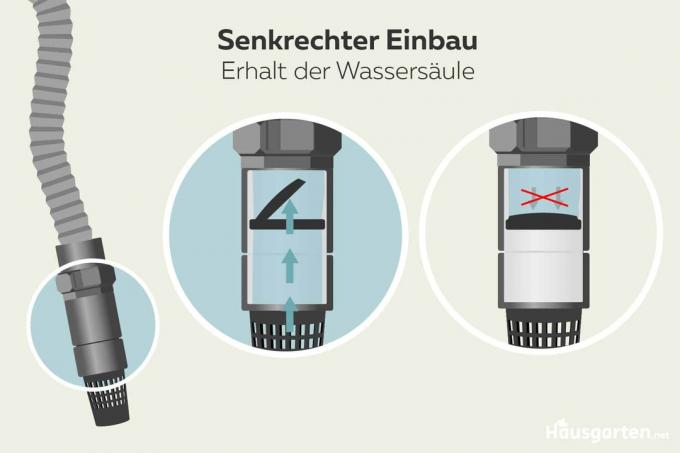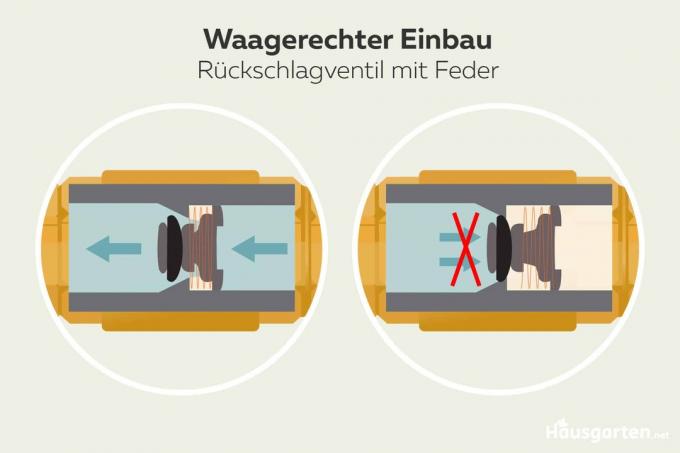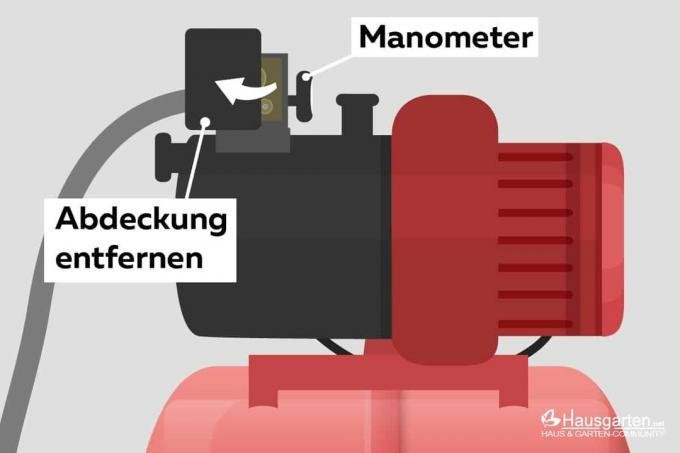

Table of contents
- Operating principle of the check valve
- Vertical installation
- Horizontal installation
- note direction
- Make the right choice
- Perform maintenance
With pumps, the direction of flow is crucial for reliable operation. A non-return valve can ensure the right direction and thus serves as an additional or necessary security. But how is it installed?
Operating principle of the check valve
A check valve is a component that connects hoses or pipes together and can therefore be used between different components. Water or gas passes through the valve. Inside, however, it has a flap that, in the opposite direction to the desired flow, seals the opening tightly as soon as it is subjected to pressure.
Thus, for example, the medium can flow back from right to left but not from left to right. The same is true in the vertical direction. If a liquid has to be pumped from the bottom up, the valve prevents backflow down. This makes it possible, among other things, to lower the pump.
Vertical installation
As a rule, check valves are installed vertically in the following cases:
- garden pumps
- heating pumps
- on washing machine drains
- Well pumps for pumping water
- pond pumps
In any case, it is important that a suitable valve is used for vertical installation. Not every model is suitable for this.

In addition, the installation must be consistent. Here the direction and the connecting pieces are crucial. The respective purpose of use must also be observed. When it comes to maintaining a water column, the water must not flow back down and out of the hose.
On the other hand, if backflow into the pump is to be avoided, the valve must be fitted after dispensing.
Horizontal installation
In some cases it is unavoidable that the valve has to be installed horizontally. This is the case, for example, when there is little or no difference in height or when there is no space.
These include, among others:
- longer lines
- higher drains
- Connections between pumps and larger vessels
Horizontal mounting can only be done with models designed for it. You usually need a spring as additional equipment in order to seal it really tightly and thus prevent the reverse movement.
So you have to pay attention to this when making your selection.

Tip:
An alternative to this is the angled design. It is widespread and combines both a vertical and a horizontal course.
note direction
Check valves always have an arrow showing the direction of water or gas flow. Typically, the arrow should point away from the pump to prevent water from flowing back. This applies to washing machines, for example, if a non-return valve is installed between the hose and the drain pipe.
It can look different when water is sucked in and a column is to be formed. This is often useful for larger pumping depths. Here the arrow must point to the pump so that the water can be attracted more easily and safely. It then no longer runs out of the hose because it is stopped in stages. This also prevents air from being drawn in.
Tip:
The connection to the hoses and the type of hose are just as important as the valve itself and the flow direction. A vacuum must be able to develop in the hose, which means that the seals also play a major role.
Make the right choice
On the one hand, it is important that the valve is designed for the direction of flow or the direction of assembly. These can be found both at hardware stores and online. There is usually a much larger selection online. In addition, more comprehensive descriptions are available here and the search is easier.
The following are important when making a purchase decision:
- Mounting direction, horizontal or vertical
- Design of the valve, straight or curved or shaped as an angle
- Integrated spring
- size of the connections
- material
A targeted search in the hardware store is often not as easy as it is on the Internet. Therefore, the purchase here is particularly useful if you do not have extensive experience with check valves.
Tip:
High-quality metal valves are a little more expensive to buy, but are more durable and have a longer service life.
Perform maintenance
Not only the direction of installation and the equipment are important when selecting the check valve. Since the valves have to be maintained regularly and flushed out or even replaced if necessary, they must also be easy to access.
They should therefore always be attached in such a way that a check can be carried out easily. In addition, quick and easy detachment should not be in favor of density.
 Home editorial office
Home editorial office
Learn more about water

Drain in the shower stinks: these 7 home remedies will help
If the drain in the shower stinks, it can be unpleasant not only during use. Bad smells from the pipes can spread throughout the bathroom. This guide shows how the problem can be solved with home remedies.

Water consumption when showering in liters per minute
Anyone who knows how much water is consumed when showering in liters can use this to reduce costs in a targeted manner. Especially with regard to rising energy prices and a more conscious use of resources, there is often an undreamt-of savings potential.

Domestic waterworks: how to increase the pressure
With a domestic waterworks it may be necessary, depending on the depth, to increase the pressure. But how can the setting be made and when is it necessary to make an adjustment? All important information can be found here.

Domestic waterworks: set the pressure correctly
Adjusting the pressure correctly in a domestic waterworks is very easy with the appropriate knowledge. Our guide shows how the measure should be carried out and what to look out for.

Domestic waterworks does not draw water: what to do?
If the domestic waterworks does not draw water, the question arises: what to do? The answer depends on the type of pump and the problem at hand. Our guide shows possible causes and solutions.

Domestic waterworks does not switch off: what to do?
If the domestic waterworks runs continuously and does not switch off, there can be several reasons for this. At the same time, the permanent running of the domestic waterworks poses a significant problem. Here we show what can be done about it.



